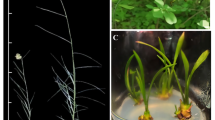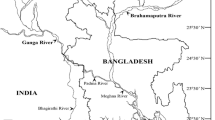Abstract
The imperial bromeliad Alcantarea imperialis grows naturally on rocky outcrops (‘inselbergs’) in regions where daily temperatures vary from 5 to 40°C. As carbohydrate metabolism is altered in response to cold, it could lead to reprogramming of the metabolic machinery including the increase in levels of metabolites that function as osmolytes, compatible solutes, or energy sources in order to maintain plant homeostasis. The aim of this study was to evaluate the effects of different temperatures on plant growth and non-structural carbohydrates in plants of A. imperialis adapted to low temperature. Seedlings of A. imperialis were grown in vitro under a 12-h photoperiod with four different day/night temperature cycles: 5/5°C, 15/15°C, 15/30°C (dark/light) and 30/30°C. Plants were also cultivated at 26°C in ex vitro conditions for comparison. The results showed an inverse relationship between temperature and germination time and no differences in the percentage of germination. Plants maintained for 9 months at 15°C presented a reduced number of leaves and roots, and a dry mass four times lower than plants grown at 30°C. Sugar content was higher in plants grown at 15°C than at 30°C. However, the highest amount of total sugar was found in plants growing under warm day/cold night conditions. Myo-inositol, glucose, fructose and sucrose were found predominantly under high temperatures, while under low temperatures, sucrose was apparently replaced by trehalose, raffinose and stachyose. Starch content was highest in plants grown under high temperatures. The lowest starch content was detected under low temperatures, suggesting its conversion into soluble carbohydrates to protect the plants against cold. These results indicated that low temperature retarded growth of A. imperialis and increased sugar levels, mainly trehalose, thus suggesting that these sugar compounds could be involved in cold tolerance.






Similar content being viewed by others
References
Amaral LIV, Costa PMF, Aidar MPM, Gaspar M, Buckeridge MS (2007) Novo método enzimático rápido e sensível de extração e dosagem de amido em materiais vegetais (New and sensitive method for extractation and quantification of starch from plant materials). Hoehnea 34:425–431. (http://www.ibot.sp.gov.br/publicacoes/hoehnea/vol34/vol34.php
Amoo SO, Finnie JF, Staden JV (2009) Effects of temperature, photoperiod and culture vessel size on adventitious shoot production of in vitro propagated Huernia hystrix. Plant Cell Tissue Organ Cult 99:233–238
Bae H, Sicher R, Natarajan S, Bailey B (2009) In situ expression of trehalose synthesizing genes, TPS1 and TPPB, in Arabidopsis thaliana using the GUS reporter gene. Plant Cell Tissue Organ Cult 98:311–319
Benson EE, Danaher JE, Pimbley IM, Anderson CT, Wake JE, Daley S, Adams LK (2000) In vitro micropropagation of Primula scotica: a rare Scottish plant. Biodivers Conserv 9:711–726
Benzing DH (2000) Bromeliaceae–profile of an adaptive radiation. Cambridge University Press, Cambridge
Bergmeyer HU (1974) Methods of enzymatic analysis. Academic Press, New York
Blázquez MA, Santos E, Flores C-L, Martínez-Zapate JM, Salinas J, Gancedo C (1998) Isolation and molecular characterization of the Arabidopsis TPS1 gene, encoding trehalose-6-phosphate synthase. Plant J 13:685–689
Carvalho MAM, Dietrich SM (1993) Variation in fructan content in the underground organs of Vernonia herbacea (Vell.) Rusby at different phenological phases. New Phytol 123:735–740
Drennan P, Smith M, Goldsworthy D, Staden J (1993) The occurrence of trehalose in the leaves of the dessication tolerant angiosperm Myrothamnus flabellifolius Welw. Plant Physiol 142:493–496
Dubois M, Gilles A, Hamilton JK, Rebers PA, Smith F (1956) Colorimetric method of determination of sugars and related substances. Anal Chem 28:350–355
Elbein AD, Pan YT, Pastuszak I, Carroll D (2003) New insights on trehalose: a multifunctional molecule. Glycobiol 13:17R–27R
Fernandez O, Béthencourt L, Quero A, Sangwan RS, Clément C (2010) Trehalose and plant stress responses: friend or foe? Trends Plant Sci 15:409–417
Goddijn O, Smeekens S (1998) Sensing trehalose biosynthesis in plants. Mini Rev Plant J 14:143–146
Gonçalves S, Fernandes L, Romano A (2010) High-frequency in vitro propagation of the endangered species Tuberaria major. Plant Cell Tissue Organ Cult 101:359–363
Guy CL, Huber JLA, Huber SC (1992) Sucrose phosphate synthase and sucrose accumulation at low temperature. Plant Physiol 100:502–508
Guy CL, Kaplan F, Kopka J, Selbig J, Hincha DK (2008) Metabolomics of temperature stress. Physiol Plant 132:220–235
Hincha DK, Popova AV, Cacela A (2006) Effects of sugars on the stability of lipids membranes during drying. In: Leitmannova LA (ed) Advances in planar lipid bilayers and liposomes. Elservier, Amsterdam, pp 189–217
http://www.biodiversitas.org.br/florabr/lista_florabr.pdf. Access on 21 Jan, 2011
Hua J (2009) From freezing to scorching, transcriptional responses to temperature variations in plants. Curr Opin Plant Biol 12:568–573
Islam MT, Dembele DP, Keller ERJ (2005) Influence of explant, temperature and different culture vessels on in vitro culture for germplasm maintenance of four mint accessions. Plant Cell Tissue Organ Cult 81:123–130
Janská A, Marsík P, Zelenková S, Ovesná J (2010) Cold stress and acclimation–what is important for metabolic adjustment. Plant Biol 12:395–405
Jenkins DW (1998) Bromeliad encyclopedia florida council of Bromeliad societies. http://fcbs.org/. Accessed 15 Feb 2010
Kanaya KI, Chiba S, Shimomura T (1978) Thin-layer chromatography of linear oligosaccharides. Agric Biol Chem Tokyo 42:1947–1948
Kaplan F, Sung DY, Guy CL (2006) Roles of alpha-amylase and starch breakdown during temperatures stress. Physiol Plant 126:120–128
Klerk GJ, Pumisutapon P (2008) Protection of in vitro grown Arabidopsis seedlings against abiotic stresses. Plant Cell Tissue Organ Cult 95:149–154
Long B, Niemiera AX, Cheng Z, Long C (2010) In vitro propagation of four threatened Paphiopedilum species (Orchidaceae). Plant Cell Tissue Organ Cult 101:151–162
Lunn JE (2007) Gene families and evolution of trehalose metabolism in plants. Func Plant Biol 34:550–563
Lunn JE, Feil R, Henriks JHM, Gibon Y, Morcuende R, Osuna D, Scheible W-R, Carillo P, Hajirezaei M-R, Stitt M (2006) Sugar-induced increases in trehalose 6-phosphate are correlated with redox activation of ADPglucose pyrophosphorylase and higher rates of starch synthesis in Arabidopsis thaliana. Biochem J 397:139–148
Mallón R, Rodríguez-Oubina J, González ML (2010) In vitro propagation of the endangered plant Centaurea ultreiae: assessment of genetic stability by cytological studies, flow citometry and RAPD analysis. Plant Cell Tissue Organ Cult 101:31–39
Martin CE (1994) Physiological ecology of the Bromeliaceae. Bot Rev 60:1–82
Murashige T, Skoog F (1962) A revised medium for rapid growth and bioassays with tobacco tissue culture. Physiol Plant 15:473–479
Nievola CC, Kraus JE, Freschi L, Souza BM, Mercier H (2005) Temperature determines the occurrence of CAM or C3 photosynthesis in pineapple plantlets grown in vitro. In Vitro Cell Dev-Pl 41:832–837
Nishizawa A, Yabuta Y, Shigeoka S (2008) Galactinol and raffinose constitute a novel function to protect plants from oxidative damage. Plant Physiol 147:1251–1263
Paul MJ, Primavesi LF, Jhurreea D, Zhang Y (2008) Trehalose metabolism and signaling. Annu Rev Plant Biol 59:417–441
Peterbauer T, Richter A (2001) Biochemistry and physiology of raffinose family oligosaccharides and galactosyl cyclitols in seeds. Seed Sci Res 11:185–197
Pompelli MF, Fernandes D, Guerra MP (2006) Germination of Dyckia encholirioides (Gaudichaud) Mez var. Encholirioides under saline conditions. Seed Sci Tech 34:759–763
Schluepmann H, Paul M (2009) Trehalose metabolites in Arabidopsis—elusive, active and central. In: Somerville CR, Meyerowitz EM (eds) The arabidopsis book. American Society of Plant Biologists, Rockville. doi:http://www.aspb.org/publications/arabidopsis/
Vogel G, Aeschbacher RA, Müller J, Boller T, Wiemken A (1998) Trehalose-6-phosphate phosphatases from Arabidopsis thaliana: Identification by functional complementation of the yeast tps 2 mutant. Plant J 13:673–683
Yamazaki H, Ayabe K, Ishii R, Kuriyama A (2009) Desiccation and cryopreservation of actively-growing cultured plant cells and protoplasts. Plant Cell Tissue Organ Cult 97:151–158
Acknowledgments
This work is part of MS thesis of L. Mollo in the Plant Biodiversity and Environment Program/Instituto de Botânica, SMASP, São Paulo and was supported by FAPESP (Grant 05/04139-7). The authors thank CNPq for the technical fellowship to M. P. Monteiro. R. C. L. F.-R. is a researcher associated with CNPq. We also thank Dr M. A. M. Carvalho (Institute of Botany, São Paulo) and Dr J. Lunn (MPIMP-Golm) for the English revision and many helpful suggestions regarding this manuscript.
Author information
Authors and Affiliations
Corresponding author
Rights and permissions
About this article
Cite this article
Mollo, L., Martins, M.C.M., Oliveira, V.F. et al. Effects of low temperature on growth and non-structural carbohydrates of the imperial bromeliad Alcantarea imperialis cultured in vitro. Plant Cell Tiss Organ Cult 107, 141–149 (2011). https://doi.org/10.1007/s11240-011-9966-y
Received:
Accepted:
Published:
Issue Date:
DOI: https://doi.org/10.1007/s11240-011-9966-y




